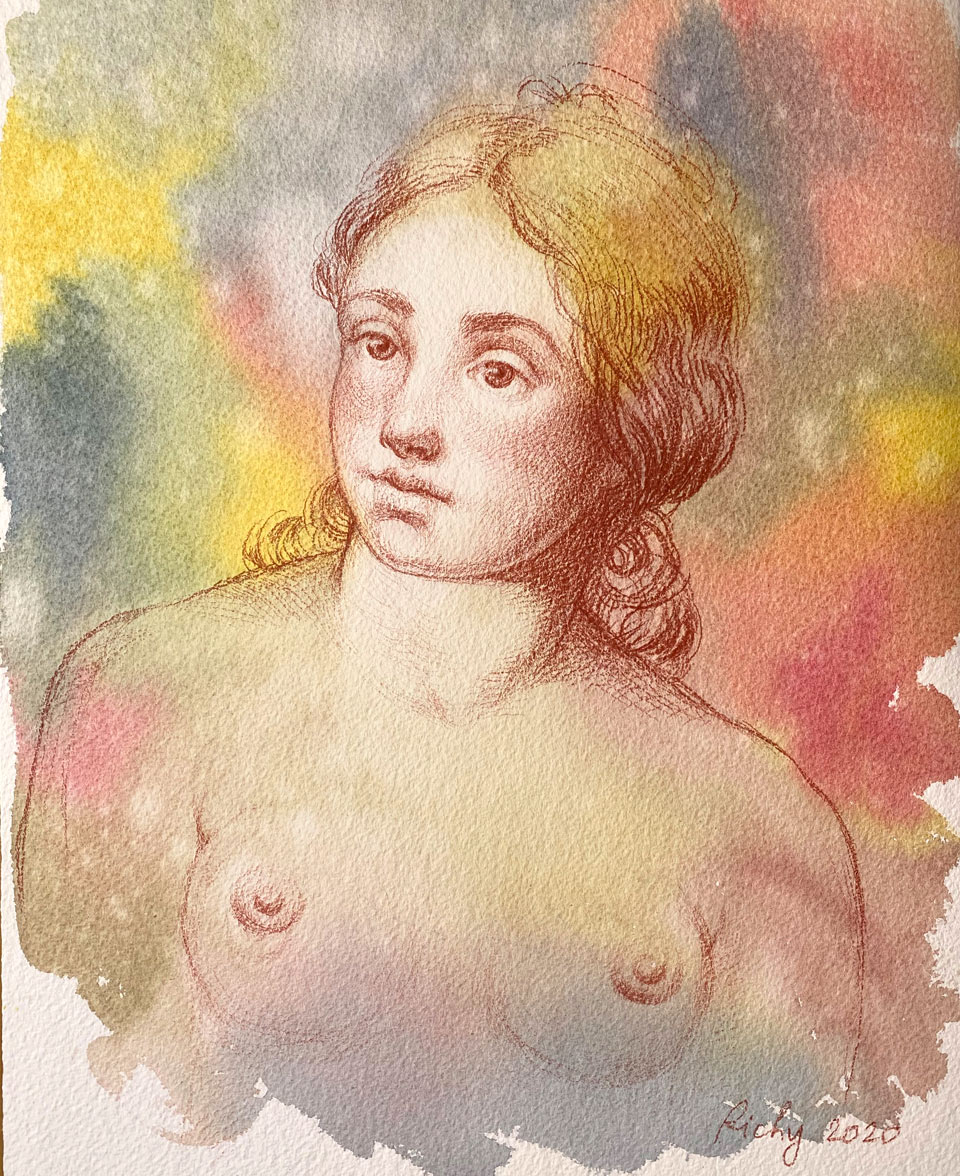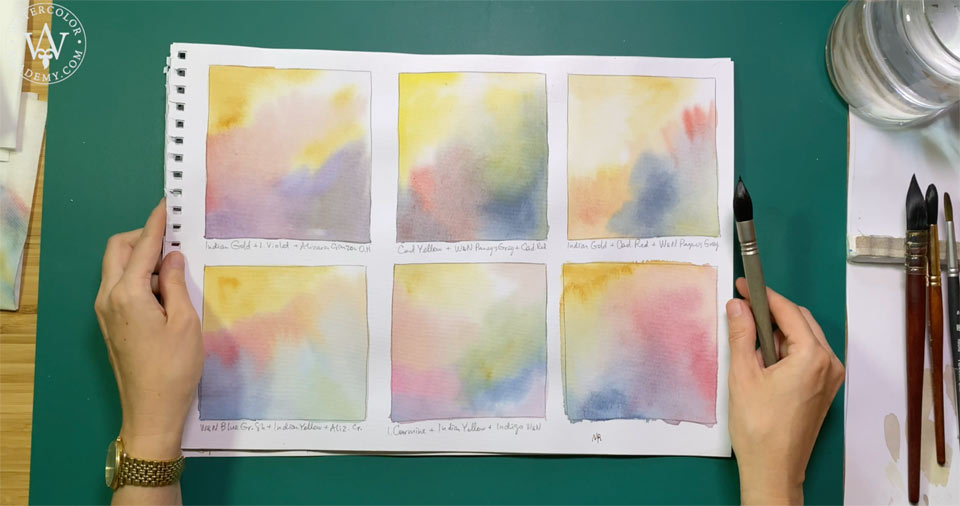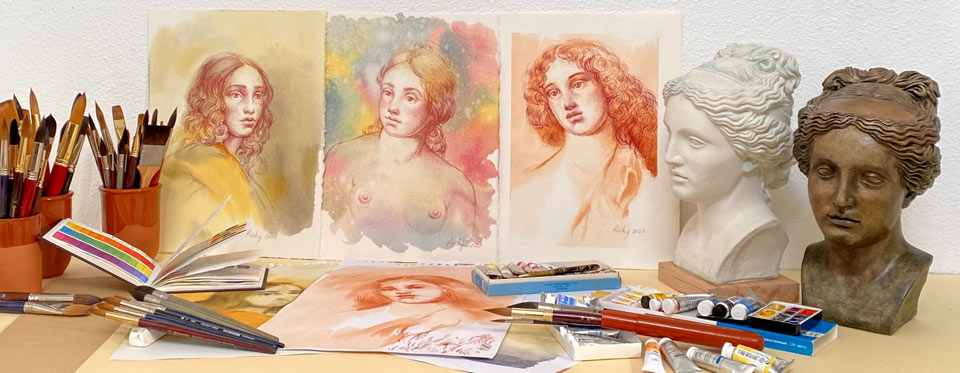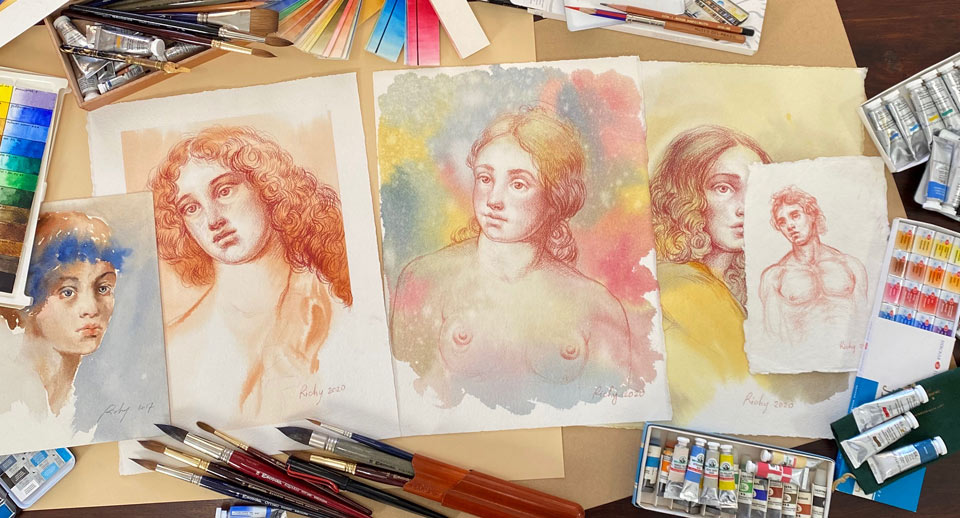A self-study, self-paced course where you can learn how to paint in watercolor by watching video lessons and doing assignments
$297 USD
ENROLL NOWA self-study, self-paced course where you can learn how to paint in watercolor by watching video lessons and doing assignments
$297 USD
ENROLL NOWOne-to-one, unlimited and custom-tailored to your skills and needs Personal Tutoring by the Watercolor Academy teachers
$997 USD
ENROLL NOWThree-color portrait by Natalie Richy
In this video, you will discover how to paint a three-color portrait in watercolor using the wash-and-outline technique.
Here is the mixed-media portrait that Natalie will create by the end of this video.

This portrait was a preliminary artwork, of a much bigger oil painting, which Natalie created in the style and technique of the Old Masters. If you would like to learn how to paint like the Old Masters using modern materials, you can take the Old Masters Academy online video course. In this course, you will learn how to paint in oil using traditional painting techniques employed by the Old Masters, and with personal support from the course tutor, Natalie Richy.
To begin this artwork, Natalie will first transfer the portrait outlines from the tracing paper to the high quality watercolor papersheet, which is made of 100% cotton, has 300gsm weight, and comes with a rough surface. The graphite sketch on the tracing paper was essential for working on the composition and scale of this artwork, as well as for fine-tuning all the details and facial features of the portrait. To decide which colors to use, you may first test different paints on a spare sheet of paper, to see how they complement each other and what type of mixes they produce. You may also make some variegated washes, to check how a future portrait background may look like.

The three paints that will be used for this artwork are: Indian Gold from a Saint-Petersburg manufacturer, Payne's Gray and Alizarine Crimson Lake Extra from Old Holland. To prepare the watercolor paper for the variegated wash, Natalie first wets the reverse side with clean water using a flat soft synthetic brush. This is 300gsm weight paper, so it will take a few minutes for the sheet to soak water and absorb it. After this, turn the sheet over and place it on the plastic board. The wet surface of paper sticks to the plastic nicely, holding the watercolor sheet firmly in place. After this, Natalie applies water onto the face side of the paper sheet.
Overall, this process takes about 10 minutes, which allows the watercolor paper to be ready for painting. In the meantime, whilst the paper is still absorbing water, it's time to premix the three pigments. As is apparent from its name, the Alizarine Crimson Lake Extra paint is very transparent. The Payne's Gray paint is a convenient mix of 3 pigments, including Ultramarine and Mars Black. And finally, the Indian Gold is also a mix of two pigments: yellow and red. By the time the artist has premixed the three pigments, the watercolor paper surface is satin, and therefore not highly reflective but is wet on touch, ready to take the paint nicely. The background for this portrait artwork will be made with the variegated wash watercolor painting technique.
All pigments are applied wet-into-wet, with different colors slightly overlapping each other, which makes it easier to diffuse the borders between different colors. Yellow and red pigments are applied in random order, with free-flowing brushstrokes, without much attention to the drawing in graphite. The Payne's Gray mix is quite dark, so it has to be diluted to stay in tune with the other colors. Because it is a very abstract background, the creative task is not to depict something recognizable, but to make a nice combination of different colors, placing them next to each other in a random order. Three paints can also be mixed on the palette to obtain new colors, which can be used to paint the flesh.

You may see that even for the model's body, such colors are applied almost randomly, with very little regard for the figure's construction and anatomy. The task for now is not to create a recognizable portrait, but to make a multicolor underpainting using only three paints. That is why the facial features are marked so loosely and lightly. For the final step of the watercolor painting, the background is sprayed with clean water, after which the board is tilted at different angles, allowing the wet paint to flow in various directions and therefore intermix far greatly on the watercolor paper sheet surface. Afterwards, the sheet should be dried thoroughly. When the watercolor paint dries, it becomes lighter and duller, as it is undergoing the drying process.

Now, the portrait drawing can begin, using colored pencil. To answer your question: 'which pencil shall I use?', it depends on your creative task. You don't have to use a colored pencil; it can be any drawing medium of your choice. If you like drawing in pen and ink, that would be great. For example, you may choose sepia ink, which has a warm brown color, and will look very good in combination with three watercolor paints that an abstract background was painted with. Alternatively, you can draw a portrait in red chalk or black charcoal, or maybe even carbon pencil – in other word, whichever drawing medium you like. It is not about the choice of pencil, but your knowledge and experience of portrait drawing skills.
There is one important skill that you need above all – a knowledge of human anatomy for artists. If you don't have much time to learn this, the Anatomy Master Class is an ideal solution for you. In this online video course, you will learn the anatomy for artists in a fast and easy way. Anatomy for artists is great knowledge to have, as long as you have fundamental drawing skills, which include how to draw in perspective, how to use rules of composition, how to render tonal values, how to apply golden proportions, and so on. Such skills are taught in the Drawing Academy online video course. This course is suited for both beginners and intermediate students.
If you already have good drawing skills, and all that is missing is the know-how of figure and portrait drawing, the best place you can learn this is the Life Drawing Academy online course. It is a self-paced, self-study course, where you will learn by watching 52 video lessons covering how to draw human figures and portraits from life, memory and imagination. Additionally, if you would like have dedicated art teachers, who will provide you with unlimited, personal, one-to-one tutoring, the best option for you is to take the Life Drawing Academy Correspondence course.
A self-study, self-paced course where you can learn how to paint in watercolor by watching video lessons and doing assignments
One-time payment - Lifetime membership
$297 USD
One-to-one, unlimited and custom-tailored to your skills and needs Personal Tutoring by the Watercolor Academy teachers
One-time payment - Lifetime membership
$997 USD